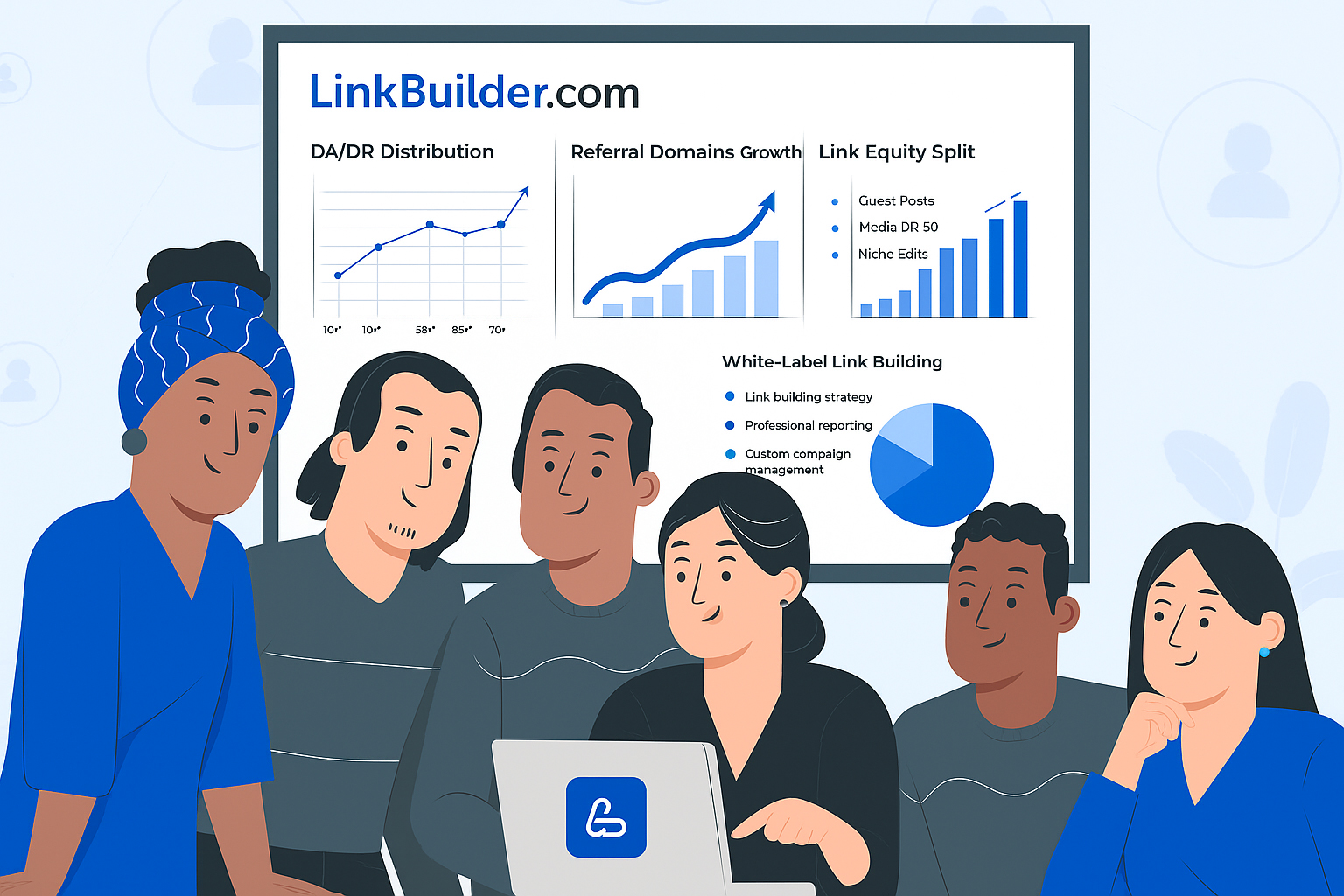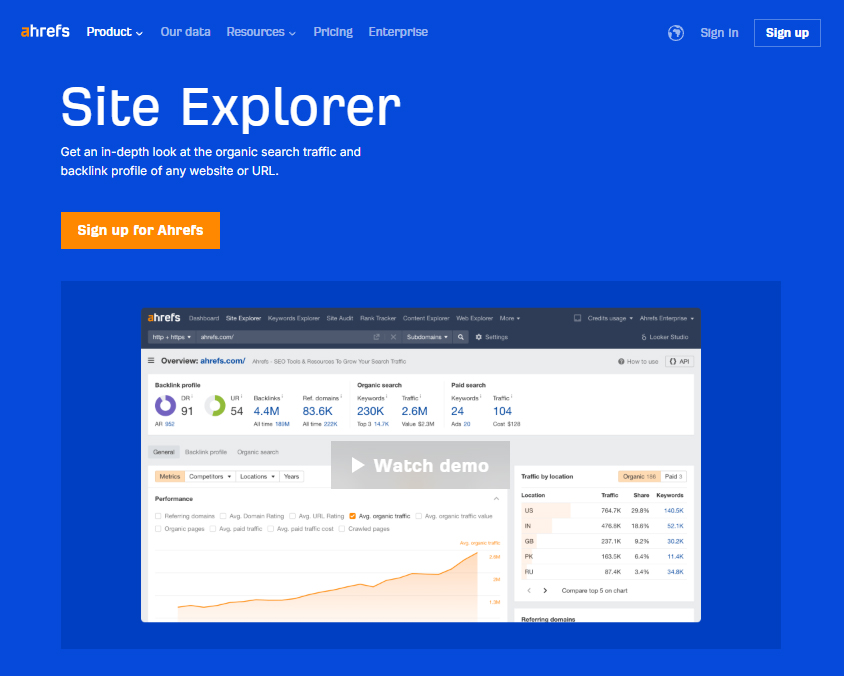Imagine a link you don’t have to buy, beg for, or negotiate endlessly to secure. It’s placed by a journalist from a top-tier online publication because they genuinely believe your brand, research, or service deserves a wider audience. These links don’t just pass authority to your website – they build trust with users, expand reach, strengthen your brand’s market position, and boost your search engine rankings.
These are editorial links – the most valuable type of mention, nearly impossible to fake or automate.
The benefits are numerous and enticing, but how do you achieve this effect in practice? In a fiercely competitive online landscape, where PR agencies flood newsrooms with press releases daily and media outlets seek new ways to monetize every pixel and news hook, what’s the secret? It lies in a well-crafted system: strategic brand positioning, creating trustworthy unique content, and skillfully integrating into editorial processes without breaching ethical boundaries or risking a questionable reputation.
In this article, we’ll dive into how editorial backlinks work, why they’re critical for SEO in 2025, and how to systematically build a strategy to earn mentions on top domains.
What Are Editorial Links?

To answer the question what is an editorial link, it’s first essential to note that these are links that arise organically when other websites reference your content without your direct request or agreement. Such links are highly valuable for SEO because they signal trust to search engines, enhance your site’s authority, and drive organic traffic.
These could be links to your original research, insightful infographics, expert commentary, analytical data, unique case studies, technical articles, or even an innovative approach to a common problem.
An editorial link is direct proof that someone in the online space found your content authoritative, informative, or engaging enough to include in their publication. It’s the result of the content’s inherent logic, not external influence. It’s when an author, to fully convey the depth, accuracy, or truth of their material, chooses to cite an authoritative source – and that source is you.
A key characteristic of these mentions is that they always reflect the author’s genuine opinion and rarely occur by chance. Every editorial link stems from a need: to clarify, illustrate, amplify, or validate the material. If your content meets that need, the likelihood of earning a quality mention skyrockets.
Another hallmark of editorial links is their contextual naturalness. They don’t feel like misplaced ads or promotional inserts but blend seamlessly into the text. This format fosters reader trust, as the link appears as a logical part of the content, not an intrusive suggestion.
It’s also critical to understand that editorial links cannot typically be obtained on demand. You can’t simply email an editor and ask them to mention your site. However, you can – and should – create conditions where such a mention feels logical, appropriate, and even essential.
Types of Links: Editorial vs. Earned
When building a brand’s link profile, it’s vital to recognize that not all links are created equal. They vary in nature, user trust, and impact. Among the most common types in modern SEO link-building are editorial links and earned links (those acquired through outreach strategies). Both can appear on relevant, high-quality domains, but their acquisition methods, trust levels, and long-term impact on search engines differ significantly.
Editorial links emerge independently, without your direct involvement. They result from an organic process where a journalist, blogger, or content creator discovers and cites your content, deeming it a valuable resource or primary source. No deals, payments, or persistent pitches are involved. These backlinks signify that your material was genuinely useful, informative, or relevant to their content.
Earned links, on the other hand, result from your proactive efforts. You initiate the process by pitching materials to editors, website owners, or content creators, proposing topics, providing links, or crafting guest posts with embedded links. These links can be highly valuable and effective, but their impact depends heavily on the context and naturalness of their integration.
For clarity, here’s a comparison table highlighting the key differences between editorial and earned links:
| Criterion | Editorial Links | Earned Links |
|---|---|---|
| Acquisition Method | Without your involvement, initiated by the author | Through outreach strategies, pitch emails, or agreements |
| Reason for Mention | The author needs to cite an expert, quality, or relevant source | Response to your pitch or proposal |
| Placement Context | Naturally integrated into the text, non-promotional | Often carries a promotional undertone |
| Likelihood of Retention | High. Authors independently choose reliable sources | Varies. Links may be edited or removed |
| Search Engine Trust | High. Strong signals of excellent reputation | Varies. Context and naturalness are key |
| SEO Value | Considered the most reliable authority signal | Impact depends on the site’s quality and link relevance |
Editorial links are deemed more trustworthy by search engine algorithms, contributing to a robust link profile that’s harder to manipulate artificially. They typically feature well-crafted anchor text, natural context, and high relevance to the donor page. Moreover, these mentions often appear on authoritative sites with steady traffic and engaged audiences, providing bonuses for referral traffic and enhancing E-E-A-T (Experience, Expertise, Authoritativeness, and Trustworthiness) – key criteria for Google’s evaluation of resources.
Earned links can also be highly effective for SEO, especially when adhering to best practices: avoiding spammy anchor text, not duplicating content for manipulation, and choosing high-quality domains for backlinks.
When working with any links, remember that search engines are increasingly adept at detecting manipulative link-building patterns. Mentions that appear forced, overly promotional, or inauthentic lose effectiveness and popularity.
Fortunately, platforms like LinkBuilder.com offer professional guest posting and outreach services, helping brands secure high-quality backlinks from authoritative sources. Their expertise in link-building ensures an effective content promotion strategy, boosting brand trust and search visibility.
Top Advantages and Disadvantages of Editorial Links

Editorial links play a crucial role in shaping a website’s SEO profile, driving not only traffic growth but also establishing a reputation as a reliable source in the eyes of search engines. As they arise organically – when authoritative sites link to your content due to its genuine value, not through exchanges or paid agreements – editorial backlinks serve as “trust signals” for search engines.
These backlinks have a direct and lasting impact on a webpage’s search visibility. Their effect can be evaluated through several key SEO factors:
- Domain Authority Transfer
When a relevant industry media or niche resource links to your site, a portion of their domain authority is passed to your webpage, boosting your overall domain ranking in search engine algorithms. - Strengthened Backlink Profile
Google and other search engines favor backlinks from high-quality, relevant sources. Mentions of your brand on such platforms help form an organic link profile, essential for long-term link-building strategies. - Thematic Relevance
Most editorial links appear in closely related contexts, enabling search engines to accurately identify your site’s topic and improve rankings for targeted queries. - Safe Anchor Impact
Editorial authors rarely use overly optimized, keyword-stuffed anchors, opting for natural phrasing. This keeps your link profile safe from suspicions of manipulation or spam. - Enhanced E-E-A-T Signals (Experience, Expertise, Authoritativeness, Trustworthiness)
Frequent mentions on thematic, authoritative platforms reinforce your brand’s expertise and reliability for both search algorithms and your target audience. - Faster Indexing of New Pages
Quality links from sites frequently crawled by Google can accelerate the indexing of new or updated pages, critical for news-driven or dynamic sites. - Indirect Behavioral Benefits
Editorial mentions often drive organic traffic, improving behavioral metrics like time on site and bounce rates, which algorithms consider when assessing site quality.
Additionally, it’s vital to emphasize that editorial links are more than mere mentions in major media or blogs – they are unique SEO assets. However, despite their effectiveness, they aren’t a magic solution for your marketing strategy. Editorial links come with both undeniable advantages and significant challenges.
✅ Advantages:
- Increased Site Authority
Editorial backlinks are the most natural and effective way to earn search engine trust. Links from reputable publications signal that your content is valuable, verified, and noteworthy, directly impacting Domain Authority and PageRank. - Enhanced Brand Reputation
A single mention of your company, product, or service in materials from an influential source or industry leader boosts trust. This acts as a form of verification: if an authoritative source cites you, you’re a significant market player, not a random entity. - Organic, Relevant Traffic Growth
Editorial mentions deliver not just technical SEO weight but real users. Audiences of major media are more likely to click links to engaging content, driving traffic and improving lead generation. - Safe Promotion Strategy
In SEO, editorial links are a 100% “white-hat” link-building method, minimizing risks of penalties or suspicion from search algorithms. - Improved Brand Recognition
Beyond SEO, editorial links enhance marketing and reputation efforts. A brand featured in a leading publication automatically gains visibility, fostering a strong online presence, especially in competitive niches. - Connections with Authoritative Platforms< Megan> Editorial links often result from networking with journalists, industry experts, and community members, opening doors for further collaborations, interviews, conference invitations, or joint initiatives that expand audience reach.
- Long-Term Impact
Many editorial links remain effective for years. Even with article updates, mentions typically persist, delivering steady traffic and retaining SEO value 2–3 years post-publication. - Positive Relevance and Quality Signals
Search engines evaluate not just the mention itself but its context – page topic, source, format, and tone. Links in expert reviews, analytical reports, or op-eds strengthen your site’s topical associations.
Thanks to these numerous benefits, brands that effectively leverage editorial links gain a competitive edge. However, despite their clear advantages, editorial links are a resource-intensive tool requiring significant effort and patience.
❌ Disadvantages and Challenges:
- High Acquisition Difficulty
Earning links from authoritative sources demands standout content like research, guides, infographics, or market analyses. It must be unique and flawlessly executed, as a good article alone isn’t enough – a robust strategy is essential. - Scaling Challenges
Regardless of your strategy, securing dozens of editorial links monthly is tough. They require personalized approaches, long-term relationship building, source vetting, and waiting for organic placement. This isn’t a process easily planned as a high-volume routine. - Limited Keyword Control
SEO specialists often rely on precise anchor strategies, but editorial links offer minimal anchor control. Authors decide the linked text, which may be generic (e.g., “here,” “source”), reducing SEO value for specific keywords. - Risk of Link Loss Over Time
Content on major media or blog platforms frequently changes – articles are updated, edited, or archived. If an article is removed or your mention is edited out, the link disappears. Without regular monitoring, you risk losing quality backlinks unnoticed. - Significant Indirect Costs
While editorial links are free in terms of placement, the resources invested can be substantial. High-quality content creation, promotional campaigns, market research, visual development, and analytics all demand time and budget. - Dependence on External Editorial Decisions
You can’t force journalists, authors, or editors to link to your site. Even with quality content, your mention may be replaced by a competitor’s or omitted entirely, creating unpredictable outcomes.
How to Secure High-Quality Editorial Links: Effective Strategies and Step-by-Step Guide

Obtaining high-quality editorial links is a strategic process requiring effort, time, and organization. Unlike links gained through purchases or exchanges, editorial links stem from the genuine value your content offers to media, journalists, or influencers willing to mention you for free.
Building editorial links involves not only creating compelling, relevant content but also forging connections with journalists, editors, and influencers in your niche who are ready to include your materials in their publications. To achieve effective results, you need a clear understanding of how to promote your content and engage with diverse platforms – from news sites to niche blogs.
In this section, we’ll explore the most effective strategies for earning editorial links and provide a step-by-step guide to help you attract a steady stream of high-quality backlinks for your brand.
Strategies for Effective Link Acquisition
To secure unique editorial links, it’s not enough to create a great website and wait for mentions. You must take a proactive, targeted approach, develop a clear strategy, and deeply understand your audience’s needs and potential partners.
Here are six key tactics to build a robust backlink profile naturally:
Create Unique, Valuable Content: Editorial links don’t appear without reason. Your content must be so valuable that authors want to cite it. What’s valuable to media and niche authors?
- Analytics and In-Depth Research: Reports with market data, proprietary analysis, or service comparisons are often used as references.
- Explanatory and Expert Guides: Being the first to thoroughly explain a complex topic or creating the best guide in your industry guarantees mentions.
- Infographics and Data Visualizations: Visual content is frequently shared and linked to without prompting.
- Interactive Tools: Calculators, interactive maps, or dashboards can promote your brand, as media often link to or mention them.
The key is to create content that begs to be referenced, targeting not just your audience but influencers shaping your industry’s information landscape.
Collaborate with Journalists via Specialized Platforms: To earn editorial links, you need visibility among content creators. Platforms bridging journalists and experts can help:
- HARO (Help a Reporter Out): Respond to journalists’ queries for expert commentary.
- Qwoted, SourceBottle, ResponseSource: Similar platforms for various markets, allowing you to pitch materials as a source.
- ProfNet (by PR Newswire): Ideal for companies seeking mentions in U.S. media.
Regularly monitoring these platforms and promptly responding to relevant queries significantly boosts your chances of authoritative mentions.
Conduct Surveys and Publish Reports: Original data is gold for media. If you have resources to collect statistics, create unique news hooks journalists will use:
- Launch online surveys among your audience or on social media.
- Compile results, comparing with past years or market data.
- Create a report with analytics, charts, conclusions, and recommendations.
- Include a press release or prepared quotes to simplify journalists’ work.
Such materials excel in B2B, competitive niches (e.g., marketing, IT, real estate), and even specialized topics like cosmetics or logistics.
Leverage News Hooks and Trends: Stay aligned with current events. News hooks are why your content is relevant now:
- React to Industry News: Offer expert opinions or analysis on recent changes or major news.
- Calendar Events: Leverage annual trends, Black Friday, or legislative changes.
- Internal Company Events: Create hooks around product launches, major updates, or achievements (awards, certifications).
Important: News hooks must be timely, relevant to your audience, and clearly convey why the topic matters today.
Build a Personal Brand: In an information-saturated world, journalists are more likely to cite recognizable, trusted figures than obscure companies. A strong personal brand for you or your team (SEO, CEO, experts) can ease earning quality mentions:
- Write columns in industry media.
- Speak at webinars, conferences, or podcasts.
- Actively engage on LinkedIn or Twitter (X), commenting on niche trends.
- Offer expert commentary to editors on current events.
Recognizable experts are more likely to be invited for editorial link-building collaborations.
Collaborate with Niche Blogs and Local Media: Don’t underestimate the impact of local or niche sources. They often shape initial brand perceptions and influence links:
- Find industry blogs, directories, or news portals relevant to your niche.
- Offer ready-made content, expert opinions, or analytical data.
- Write guest posts, not as generic SEO pieces but as meaningful media collaborations.
Learn the best outreach strategies in the article “What is Outreach?”
These links not only aid SEO but attract relevant audiences, boost lead generation, and build trust within communities.
How to Identify Opportunities for Editorial Links?
As we’ve established, editorial links don’t appear by magic. Behind every quality link lies a seized opportunity, used timely and wisely. The first step is learning to spot these opportunities, which requires understanding your niche’s information landscape, monitoring online resources, and analyzing competitors and viral trends.
Below are key ways to identify promising opportunities for natural mentions:
- Competitor and Backlink Analysis: Your competitors’ link profiles are a prime source for ideas. Analyzing their editorial mentions reveals media, blogs, or projects likely interested in your content or innovative ideas.
Use tools like:
- Ahrefs Site Explorer

- Semrush Backlink Analytics
.jpg)
- Moz Link Explorer
.jpg)
- Ahrefs Site Explorer
- Tracking Media Activities by Keywords
Another highly effective tactic is monitoring online publications based on targeted queries or topics directly related to your business activities. If journalists view your niche as a "hot" topic and regularly publish related content, this signals a high potential for organically integrating your brand into this content stream.
What approach should you take? Focus on the following platforms:
- Google Alerts – Ideal for tracking new publications based on specific keywords.
- Talkwalker Alerts or Mention – Useful for deeper monitoring of brand mentions.
- BuzzSumo – Excelsat identifying content that goes viral or is actively discussed on social media.
- Active Monitoring of Journalists on Social Media
Today, many journalists actively share their queries, ideas, and topics for upcoming articles on social media platforms, with Twitter (X), LinkedIn, Facebook groups for media professionals, Instagram, Threads, and niche communities being the most prominent. It’s crucial not only to follow insightful experts but also to respond promptly to their news hooks.
Tips for success:
- Create Twitter lists of the most relevant authors in your niche.
- Follow their updates on LinkedIn.
- Regularly check hashtags like #journorequest or #PRrequest.
- Actively participate in PR and content marketing communities.
- Researching Local Media and Niche Platforms
Sometimes, the most valuable opportunities lie in exploring smaller yet influential sources within your industry. Local news portals, thematic blogs, and professional online magazines are often open to publishing content, especially if you provide real-world case studies, compelling data, or expert insights.
How to identify such opportunities?
- Search for queries like “top blogs in [your niche]” or “industry media [your topic].”
- Use aggregators like Feedly or Inoreader tosubscribe to niche sources.
- Review local news portals and their “Editorial Partners” sections.
Important: Don’t overlook smaller websites, as they can often be your first entry point into the world of editorial link-building.
In summary, securing editorial links requires meticulous planning, high-quality content creation, and effective media engagement. Below, you’ll find a step-by-step guide to help you systematize your efforts and achieve the desired results.
Step 1: Identifying Target Media and Resources
The first step involves analyzing various media outlets, blogs, and platforms with the potential to feature links to your content. To do this:
- Analyze competitors: Use tools like Ahrefs, Semrush, or Moz to identify domains where your competitors secure backlinks. This will help you compile a list of relevant resources.
- Evaluate the authority of sources: Always check metrics like Domain Authority (DA) and Domain Rating (DR), as well as the topical relevance of the donor site.
- Organize your list: Categorize resources into groups, such as major media outlets, niche blogs, or local publications. This approach allows you to tailor your strategy for each category.
- Research platform guidelines: Some media outlets have specific requirements for published content or submission processes. Familiarize yourself with these in advance to avoid misunderstandings or potential pitfalls.
Step 2: Creating Content Worthy of High-Quality Links
High-quality content is the foundation for securing editorial links. To make it appealing to media and encourage collaboration, consider the following factors:
- Originality: Avoid overly generic or templated topics. Strive to offer fresh, unique ideas, innovative approaches, or unconventional perspectives on common issues.
- Visual appeal: Incorporate attention-grabbing visuals to engage readers and spark interest. Create infographics, videos, or interactive elements to increase the likelihood of content being shared with a broader audience.
- Practical value: Provide readers with actionable solutions, tips, or tools. Content that addresses specific problems is more valuable and in higher demand.
- Relevance: Stay updated on industry trends and current events. Relevant content significantly boosts your chances of being noticed.
- High quality: Ensure your materials are error-free. Text and other elements should be grammatically correct, logically structured, and easy to read.
Step 3: Preparing Materials for Media
Once you’ve created valuable content, adapt it for submission to media outlets. You can choose from the following options:
- Press release: Craft a concise, informative press release highlighting the key aspects of your content.
- Media kit: Prepare a package including images, speaker bios, and any additional relevant information.
- Expert quotes: Include expert commentary or quotes to enhance your content’s credibility and authority.
- Adaptation to media formats: Account for each platform’s specifics, such as visual style, content format, and target audience.
Step 4: Developing a Personalized Approach to Journalists
To ensure your outreach doesn’t get lost among dozens of similar pitches, adopt a tailored approach that considers the professional interests and working style of the journalist you’re contacting. This strategy increases the likelihood that your message will be noticed, reviewed, and used to feature a link to your brand in their article.
- Research their work: Review the journalist’s previous publications, unique style, and topics that resonate with them.
- Craft a personalized pitch: Avoid generic, uninspiring templates. Address the recipient by name and mention familiarity with their work.
- Clarity and conciseness: Keep your pitch short, informative, and include a clear call to action. Avoid unnecessary fluff that wastes the reader’s time.
- Value proposition: Explain why your content is worth publishing and how it benefits the journalist’s audience.
- Openness to collaboration: Express your willingness to provide additional information, comments, or interviews to foster future cooperation.
Step 5: Building Long-Term Relationships with Editorial Teams
Establishing successful contacts is great, but it’s only the beginning. To consistently secure editorial links, focus on building trusting, mutually beneficial partnerships with journalists and editorial teams based on respect and value for both parties.
- Regular communication: Stay in touch with journalists, even when you don’t have new content to pitch.
- Exclusive content offers: Provide journalists with exclusive industry insights or first-hand commentary on breaking news.
- Gratitude and reciprocity: Acknowledge journalists’ efforts by thanking them for featuring your content, sharing their articles on your channels, and tagging their outlets online.
- Quality feedback: Ask journalists how you can be helpful in the future to sustain mutually beneficial partnerships.
- Professional ethics: Honor agreements, be punctual, and position yourself as a reliable partner.
Step 6: Evaluating Campaign Effectiveness
It’s well-known that the quality of acquired links matters more than their quantity. Therefore, regularly assess your campaign’s success, identify which resources delivered the best results, and optimize your approach for the future.
- Link tracking: Use platforms like Ahrefs or Semrush to monitor existing and new backlinks.
- Traffic analysis: Check traffic metrics from acquired links using Google Analytics.
- Conversion evaluation: Determine which links drive desired outcomes, such as improved user behavior metrics on your site.
- Feedback collection: Engage with journalists and editors, conduct surveys, or create feedback forms for online readers to gather insights about your collaboration and their experience with your website, services, or products.
- Strategy refinement: Based on the collected data, adjust your content creation, publication, and media outreach approaches.
How to Track and Maintain Editorial Links?

An editorial link is not just a mark of your content’s quality but also a critical strategic asset that supports your long-term SEO goals. However, to keep these links effective, it’s not enough to simply acquire them – you must actively monitor and maintain their presence.
Neglecting systematic work with existing links can lead to a decline in your site’s authority, missed growth opportunities, or even the unnoticed loss of valuable links. This section will guide you through the process of tracking, evaluating, and sustaining editorial links effectively.
Tools for Link Monitoring
Monitoring backlinks is the first step toward leveraging them efficiently. Here are some proven tools to track new backlinks, check their status, analyze performance, and detect lost links promptly:
- Ahrefs: A leading tool for backlink analysis, offering insights into new, lost, or changed links, donor site authority metrics, anchor text, and HTTP status.
- Semrush: Tracks links while assessing spam risks and providing recommendations to enhance your link profile.
- Google Search Console: A free, essential tool for identifying backlinks that Google considers during indexing.
- Majestic: Offers in-depth link history analysis with Trust Flow and Citation Flow metrics to gauge source trustworthiness.
- Monitor Backlinks, Linkody Backlink Checker, BuzzSumo: Additional tools to automate daily monitoring and receive alerts about link profile changes.
Tip: Using multiple platforms simultaneously improves data accuracy and enables swift responses to link profile changes.
How to Maintain Link Quality Long-Term?
Editorial links require significant initial investment but offer lasting potential. To maximize this potential, adopt strategies to ensure their ongoing effectiveness:
- Regular Link Status Monitoring: Links can be lost due to content updates, CMS changes, or material archiving. Even major publications may edit or remove old articles. Verify that links remain active and point to the intended page.
- Anchor Text and Content Relevance Check: Over time, the context of pages hosting your links may shift. Ensure anchor text remains logical and the donor site’s content stays relevant to your topic.
- Maintain Editorial Relationships: If a link is lost, don’t hesitate to contact the author or editor. A polite, professional request highlighting your material’s value often leads to reinstatement.
- Update Your Content: Outdated pages or those with poor user experience may prompt journalists to alter or remove links. Regularly refresh target pages to preserve high-quality links.
- Attract New Editorial Mentions: Ongoing content improvement, PR efforts, and fresh news hooks encourage authors to return to you as a trusted source, creating a “chain reaction” that naturally builds your link profile.
The Importance of Regular Audits and Content Updates
Editorial links serve as both a powerful SEO factor and a channel for audience engagement, but their impact depends on the linked content remaining relevant and valuable.
- Fact Accuracy: Articles with outdated data lose value, increasing the risk of journalists replacing your link with a fresher, more relevant source. Review pages with strong links quarterly to update data.
- Visual Design and UX: Pages that load slowly, display poorly on mobile, or feature excessive ads harm user experience and reduce conversion from links. Optimize your site for speed, mobile-friendliness, and usability.
- Additional Optimization: If a page with editorial links isn’t ranking well, analyze its structure, meta tags, and internal links. Technical SEO improvements can unlock its potential.
- Redirects and 404 Errors: When changing URLs or deleting pages, ensure old links don’t lead to dead ends. Set up proper 301 redirects to preserve link value and organic traffic.
Systematic Workflow Tips:
- Create a spreadsheet to track editorial links, including URLs, publication dates, source type, topic, anchor text, and status.
- Use automated alerts (e.g., Ahrefs Alerts, Google Alerts) to stay informed about new mentions or opportunities.
- Prioritize pages with the most valuable links for regular updates and attention.
- Conduct periodic SEO audits of your link profile to identify weaknesses or growth opportunities.
- Establish a content update schedule for pages with editorial mentions to keep them fresh.
LinkBuilder.com understands the importance of tracking link quality and performance. Their platform offers an intuitive personal dashboard to keep everything under control..jpg)
After free registration, users gain access to a personalized dashboard that enables:
- Real-time tracking of link-building campaign progress.
- Monitoring of every acquired link.
- Strategy adjustments based on results.
- Detailed reports showcasing effort effectiveness.
This ensures full transparency, quick decision-making, and better results with minimal time investment.
Top 6 Practices for Attracting Editorial Links
Creating High-Quality Visual and Textual Content
One of the most effective ways to attract editorial links is by crafting content that people want to cite, share, and feature on authoritative platforms. Journalists, bloggers, and editors constantly seek high-quality, informative, and visually appealing sources. A strategic approach to visual and textual elements can make your content a magnet for backlinks.
Visual content examples include infographics, charts, interactive maps, timelines, trend graphs, comparison tables, and data visualizations. Their value lies in conveying complex information quickly. If your content illustrates statistics, research, or comparisons, complement text with engaging visuals.
For instance, an analytical article like “7 eCommerce Trends to Watch in 2025” with visualized marketing campaign results is far more likely to be cited by media than a plain list of figures..jpg)
The key to successful visuals is relevance, design, and ease of integration. Use bold or brand-aligned colors, readable fonts, and logical data structuring. Avoid clutter – core information should be digestible in seconds. Include a branded logo or watermark with your URL to increase the chances of retaining attribution when copied.
Textual content is equally critical. Strategically crafted analytical reviews, guides, resource lists (e.g., “Top 10 Best Link Exchanges for Crowd Marketing”), structured comparisons (e.g., “LinkBuilder.com vs. LinkDetective.pro: Choosing the Best Link-Building Software”), or expert opinions on trending topics perform well.
Important: Avoid “universal content.” Focus on excelling in your niche. For a marketing blog, skip “10 Gardening Tips” and write “Why online marketing is crucial in 2025” instead.
.jpg)
Data shows that content with unique information or practical tools is 2–3 times more likely to earn natural editorial links.
To facilitate citation, include clear headings, numbered lists, and pre-formatted press quotes. This simplifies journalists’ work, making it easier for them to extract and link to your content.
Ultimately, creating visuals and texts isn’t just a strategy – it’s a long-term link-building tool. The more effort you invest in quality and format, the higher the chance influential voices will notice and cite your work.
Collaborating with Media Outlets
Building partnerships with media is a stable strategy for earning editorial links, positioning you as a trusted source of valuable information. This mutually beneficial approach provides media with quality content, exclusive insights, and expertise while delivering businesses regular mentions and high-quality backlinks from authoritative platforms.
Start with thorough media landscape research. Compile a list of industry-specific, niche, and local outlets relevant to your field – major publications, specialized online journals, expert blogs, or media startups. Analyze their format: topics covered, tone, author profiles, and content structure. This helps craft relevant pitches.
To move beyond one-off pitches, offer media consistent value, clear expectations, and professional expertise. Outlets often seek reliable partners for collaborative projects like special features, thematic sections, or regular columns.
Trust is paramount. Don’t focus solely on “getting links.” Adopt a strategic, win-win mindset. Journalists and editors need dependable partners who won’t vanish after one publication.
Deliver materials on time, meet deadlines, respond promptly to requests, and be open to revisions. This builds a reputation as a reliable source, increasing repeat mention likelihood.
Another tool is formal agreements for sponsored content or columns. For example, a media outlet might publish your case studies monthly. While costlier, this format delivers strong ROI for authoritative outlets, benefiting both link-building and brand visibility.
A flexible option is guest content. Offer editors ready-made articles tailored to their style. Avoid overt promotion and focus on value. Texts that offer deep insights, clarify complex topics, or provide fresh analyses significantly boost publication and backlink chances.
Media partnerships are a long-term investment. Unlike earned links, they don’t yield instant results but lay a foundation for organic growth in brand authority for both search engines and your audience.
Repairing Broken Links
Broken link building is a highly effective yet underutilized strategy for securing quality links. It involves identifying links on external sites that point to outdated or nonexistent pages and offering your relevant content as a replacement. This approach not only places backlinks naturally but also benefits site owners by improving their audience’s user experience.
Step one is finding broken links in your niche using tools like Ahrefs, Semrush, Screaming Frog, Moz, or browser extensions (e.g., Check My Links for Chrome). These scan competitor sites, blogs, media, or relevant resources for invalid URLs.
Next, evaluate the broken link’s context. Does it align with a topic you can replace? Is your proposed content a relevant substitute? The link must fit logically, be useful, and add value to the page.
If you have matching content, contact the site owner or editor. Personalized emails work best, noting:
- The broken link’s location (page URL).
- The error it triggers (e.g., 404).
- Your similar or improved content’s value for their readers.
This approach fosters goodwill, as you’re helping maintain their site’s quality, not just requesting a link.
If no suitable content exists, consider creating it – articles, guides, analytical reports, or multimedia like infographics or videos. Ensure it’s high-quality and surpasses the original page’s utility.
Broken link building also creates a natural link profile, as these links blend organically into content and appear authentic to search engines.
Systematize your efforts:
- Create a spreadsheet of broken links, noting source, topic, editor, and contact details.
- Track pitch dates and outcomes.
- Revisit high-value sites periodically.
Creating Case Studies and Reports
One of the most powerful tools for attracting high-quality editorial links is producing case studies, analytical reports, and research that deliver unique value to your industry. This content enhances your authority and earns trust, encouraging media and bloggers to link to your resource.
How It Works: Case studies typically involve data collection, factual analysis, or specialized insights, yielding fresh perspectives or reinterpretations. They may include surveys, experiments, trend analyses, statistical research, market reviews, or expert feedback. Such content is link-worthy due to:
- Originality: Unique data, novel research, or fresh takes open new opportunities.
- Reader Value: Content solves problems or answers pressing questions.
- Relevance: Topics align with media and industry trends.
How to Create a Link-Worthy Case Study:
- Identify Topics and Issues: Focus on trending or debated topics in your niche. Use search queries, news, or competitor challenges for inspiration.
- Gather Data and Insights: Source from surveys, public datasets, expert publications, or social media. Ensure data is fresh and reliable.
- Analyze Information: Identify trends, comparisons, or new insights. Present findings clearly, logically, and accessibly.
- Visualize Data: Use infographics or charts to enhance comprehension and memorability.
- Promote and Pitch: Share via your channels (website, social media) and pitch to journalists covering related topics.
- Involve Experts: Invite thought leaders for commentary to boost credibility and encourage reciprocal linking.
Additional Benefits:
- Media Value: Offers fresh data for articles, reviews, or reports.
- Authority Building: Becomes a citable source, enhancing your market reputation.
- Media Collaboration: Sparks partnerships for co-authored content or programs.
Repurposing Old Publications for New Links
Repurposing existing content is an underrated method for earning editorial links. Many companies focus on new content, overlooking the potential of older publications. Updated materials can drive new links, traffic, and authority.
How It Works: Old posts often remain relevant and valuable. Refreshing them makes them appealing to new readers or partners, earning links that boost search rankings.
Steps for Effective Repurposing:
- Audit Old Content: Identify still-relevant posts with strong feedback or high views.
- Update Content: Revise with current trends, new data, examples, or links. Fresh content attracts citations.
- Enhance Visuals: Add infographics or charts to increase appeal and shareability.
- Seek New Link Opportunities: Pitch updated content to journalists or bloggers, explaining its value.
- Cross-Promote: Link to updated posts in new articles to drive attention.
- Fix Broken Links: If old content has broken links, request editors to update to your revised version.
Additional Benefits:
- Time and Resource Savings: Updating takes less effort than creating anew.
- Improved Rankings: New links to old posts can elevate search positions.
- New Audience Reach: Refreshed content attracts readers or media previously unaware of it.
Monitoring Unlinked Brand Mentions
Monitoring unlinked brand mentions is a potent but often overlooked strategy for earning editorial links. These are instances where your brand, product, or service is mentioned online without a direct link to your site. With the right approach, they can become valuable backlinks.
Why They Matter: Unlinked mentions are potential link sources if you convince authors to add a hyperlink. They enhance SEO, as quality backlinks are a key ranking factor. Even without links, mentions signal positive brand sentiment.
How to Find Unlinked Mentions:
- Brand Monitoring Tools: Use Google Alerts, Mention, Brand24, or BuzzSumo totrack mentions with customizable alerts.
- Search Engine Queries: Search your brand name in quotes, adding filters like product names.
- Social Media Analytics: Tools like Hootsuite or Sprout Social monitor mentions on platforms like Twitter (X), Facebook, or LinkedIn.
How to Convert Mentions to Links:
- Contact Authors: Reach out via email, social media, or listed contacts. Politely request a link, explaining how it enhances their content.
- Creative Monitoring: Look beyond tools to blogs, forums, or reviews for untapped mention opportunities.
Tips for Success:
- Be Polite and Non-Pushy: Respect authors’ policies, as some avoid linking.
- Ensure Relevance: Proposals must align with the article’s topic.
- Track and Analyze: Monitor new links’ status and refine your strategy.
Benefits:
- More Backlinks: Builds a stronger link profile for SEO.
- Expanded Contacts: Fosters relationships with journalists and bloggers.
- Enhanced Visibility: Mentions, even unlinked, boost online presence.
Why Your SEO Needs Editorial Links?

In modern SEO, editorial links are a highly effective tool for boosting search visibility. Unlike traditional links, they come from media or authoritative sites based on your content’s value, not payment or link exchanges. Here’s why they’re vital for your SEO strategy and online presence.
Key Success Factors for Attracting Editorial Links
- Identifying Quality Link Sources: Not all links are equal. Focus on authoritative media, blogs, or niche portals with high search rankings and relevance to your industry for maximum SEO impact.
- Creating Link-Worthy Content: High-quality editorial links require valuable content. Produce original, useful materials like research, infographics, or reports that attract journalists and bloggers.
- Building Media Relationships: Strong ties with journalists and editors unlock regular link opportunities. Maintain strategic, ongoing contact to boost your media reputation and SEO outcomes.
- Analyzing Competitor Links: Study competitors’ link profiles to uncover platforms and strategies for earning editorial links, refining your approach.
- Scaling Link Acquisition: Link-building is an ongoing process. Continuously expand your backlink network through new strategies, content updates, and media engagement.
Next Steps for Enhancing Your SEO Strategy
- Audit Your Backlink Profile: Analyze existing links to identify low-quality or spammy ones. Assess your editorial link count and prioritize quality growth.
- Earn New Backlinks via Content: Create viral, valuable content to attract editorial links consistently.
- Boost Link Relevance: Prioritize links tied to your niche for greater SEO impact, focusing on authoritative sources.
- Improve User Experience: Optimize site speed, mobile-friendliness, and navigation to retain visitors and encourage content sharing.
- Stay Engaged with Media: Monitor industry trends and news for timely link-building opportunities.
LinkBuilder.com is a robust tool for securing high-quality backlinks, offering tailored solutions to elevate your SEO strategy with professional editorial link-building services..jpg)
Their expert team helps identify optimal link-building solutions, track links, and analyze campaign performance.
Use their platform for ordering editorial links to automate strategy details, freeing you to focus on quality content and other marketing priorities.
With tools like LinkBuilder.com, you can enhance your SEO strategy, balancing link quality and quantity while optimizing time, effort, and costs.








